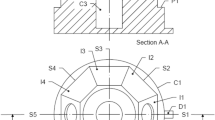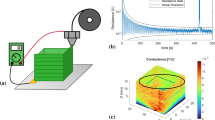Abstract
Fused Filament Fabrication (FFF) is a promising technology that is largely developed in small series, as this technology optimizes supply chains by reducing production time and costs. However, its shortcomings have slowed its adoption as a dominant production technology. Among its weaknesses, this work focuses on geometric and dimensional accuracy within tolerance range. There is a need for understanding the sources of geometrical inaccuracies and for methods of characterizing them, in order to modify the input parameters to eventually obtain the desired geometry. This work first focuses on the geometric and dimensional accuracy of parts printed by the FFF process by studying the influence of the inner radius of a cylindrical part, the type of material and the type of filling pattern. The levels with the greatest dimensional dispersion are the largest radius, the nylon material, and the hexagonal filling pattern. Secondly, a defect characterization method associated with a parametric mathematical model is developed. The 3D scanner enables the retrieval of the coordinates of the printed geometry; this allows to characterize the errors with respect to the theoretical 3D model and to modelize the printed part by a series of ellipses of which we obtain the analytical equations, as a first step of a correction process.






Similar content being viewed by others
Data availability
The experimental part was carried out in the Product Design and Innovation laboratory of the National School of Arts et Metiers. The materials used were the Mark Two™ Markforged® 3D printer, the Solutionix D500 3D Scanner, and the Geomagic® Control X™ software to recover the data of dimensional comparison between the designed part and the 3D printed model.
Code availability
Not applicable.
Change history
26 January 2023
A Correction to this paper has been published: https://doi.org/10.1007/s40964-023-00406-x
References
Huang Y, Leu MC, Mazumder J, Donmez A (2015) Additive manufacturing: current state, future potential, gaps and needs, and recommendations. ASME J Manuf Sci Eng 137(1):014001. https://doi.org/10.1115/1.4028725
Kruth JP, Leu MC, Nakagawa T (1998) Progress in additive manufacturing and rapid prototy**. CIRP Ann Manuf Technol 47(2):525–540. https://doi.org/10.1016/s0007-8506(07)63240-5
Levy GN, Schindel R, Kruth JP (2003) Rapid manufacturing and rapid tooling with layer manufacturing (LM) technologies, state of the art and future perspectives 2003. CIRP Ann Manuf Technol 52(2):589–609. https://doi.org/10.1016/s0007-8506(07)60206-6
Chua CK, Leong KF (2015) 3D printing and additive manufacturing: principles and applications, fourth edition of rapid prototy**, 978–981. World Scientific Publishing Company, ISBN
Adanur S, Jayswal A (2021) Additive manufacturing of interlaced fibrous structures. J Rapid Prototyp 27(4):671–681. https://doi.org/10.1108/rpj-05-2020-0095
Melnikova R, Ehrmann A, Finsterbusch K (2014) 3D printing of textile-based structures by fused deposition modelling (FDM) with different polymer materials. IOP Confer Series Mater Sci Eng. 62:012018. https://doi.org/10.1088/1757-899x/62/1/012018
Quan Z, Wu A, Keefe M, Qin X, Yu J, Suhr J, B, JH, Kim BS, Chou TW, (2015) Additive manufacturing of multi-directional preforms for composites: opportunities and challenges. Mater Today 18(9):503–512. https://doi.org/10.1016/j.mattod.2015.05.001
Wohlers Associates (2013) Additive Manufacturing and 3D Printing State of the Industry. Wohlers Associates, Fort Collins, CO, Wohlers Report
Jayswal A, Adanur S (2022) Effect of heat treatment on crystallinity and mechanical properties of flexible structures 3D printed with fused deposition modeling (2022). J Ind Text 51(2):2616S-2641S. https://doi.org/10.1177/15280837211064937
Dommati H, Ray SS, Wang JC, Chen SS (2019) A comprehensive review of recent developments in 3D printing technique for ceramic membrane fabrication for water purification. RSC Adv. https://doi.org/10.1039/c9ra00872a
Afrose MF, Masood SH, Iovenitti P, Nikzad M, Sbarski I (2016) Effects of part build orientations on fatigue behaviour of FDM-processed PLA material. Prog Addit Manuf 1:21–28. https://doi.org/10.1007/s40964-015-0002-3
Yao SS, ** FL, Rhee KY, Hui D, Park SJ (2017) Recent advances in carbon fiber reinforced thermoplastic composites: a review. Composit Part B. 142(2018):241–250. https://doi.org/10.1016/j.compositesb.2017.12.007
Sobha AP, Sreekala PS, Narayanankutty SK (2017) Electrical, thermal, mechanical and electromagnetic interference shielding properties of PANI/FMWCNT/TPU composites. Prog Org Coat 113:168–174. https://doi.org/10.1016/j.porgcoat.2017.09.001
Melenka GW, Cheung BKO, Schofield JS, Dawson MR, Carey JP (2016) Evaluation and prediction of the tensile properties of continuous fiber-reinforced 3D printed structures. Compos Struct 153(2016):866–875. https://doi.org/10.1016/j.compstruct.2016.07.018
Dickson AN, Barry JN, Mcdonnell KA, Dowling DP (2017) Fabrication of continuous carbon, glass and kevlar fibre reinforced polymer composites using additive manufacturing. Addit Manuf 16:146–152. https://doi.org/10.1016/j.addma.2017.06.004
Justo J, Tavara K, Garcia-Guzman L, Paris F (2017) Characterization of 3D printed long fibre reinforced composites. Compos Struct 185(2018):537–548. https://doi.org/10.1016/j.compstruct.2017.11.052
Omar Ahmed M, Syed Hasan M, Jahar Lal B (2015) Experimental investigations of process parameters influence on rheological behaviour and dynamic mechanical properties of FDM manufactured parts. J Thermoplast Compos Mater 31(15):1983–1994. https://doi.org/10.1080/10426914.2015.1127955
Fernandez-Vicente M, Calle W, Ferrandiz S, Conejero A (2016) Effect of infill parameters on tensile mechanical behavior in desktop3d printing. 3D Print Add Manufact. 3(3):183–192. https://doi.org/10.1089/3dp.2015.0036
Baich L, Manogharan G, Marie H (2015) Study of infill print design on production cost-time of 3D printed ABS parts. Int J Rapid Manuf 5(3–4):308–319. https://doi.org/10.1504/IJRAPIDM.2015.074809
Akhoundi B, Behravesh AH (2019) Effect of filling pattern on the tensile and flexural mechanical properties of FDM 3D printed products. Exp Mech. https://doi.org/10.1007/s11340-018-00467-y
Maurya S, Malik B, Sharma P (2022) Investigation of different parameters of cube printed using PLA by FDM 3D printer. Mater Today. https://doi.org/10.1016/j.matpr.2022.03.700
Alafaghania A, Qattawia A, Alrawia B, Guzman A (2017) A experimental optimization of fused deposition modelling processing parameters: a design-for-manufacturing approach. Procedia Manufact 10(2017):791–803. https://doi.org/10.1016/j.promfg.2017.07.079
Gibson I, Rosen D, Stucker B (2010) Additive manufacturing technologies rapid prototy** to direct digital manufacturing. Springer, Boston, MA
Jiang L, Ye H, Zhou C, Chen S, Xu W (2017) Parametric topology optimization toward rational design and efficient prefabrication for additive manufacturing. J Manufact Sci Eng. https://doi.org/10.1115/msec2017-2954
Sood A, Ohdar R, Mahapatra S (2009) Improving dimensional accuracy of fused deposition modeling processed part using grey taguchi method Mater, 2009. Des Mater Des 30(2009):4243–4252. https://doi.org/10.1016/j.matdes.2009.04.030
Huang Y, Leu MC, Mazumder J, Donmez A (2015) Additive manufacturing: current state, future potential, gaps and needs, and recommendations. J Manuf Sci Eng 137(1):14001. https://doi.org/10.1115/1.4028725
Aboutaleb AM, Tschopp MA, Rao PK, Bian L (2017) Multi-objective accelerated process optimization of part geometric accuracy in additive manufacturing. J Manuf Sci Eng. https://doi.org/10.1115/1.4037319
Mahesh M, Wong Y, Fuh J, Loh H (2004) Benchmarking for comparative evaluation of rp systems and processes. Rapid Prototyp J 10(2):123–135. https://doi.org/10.1108/13552540410526999
Kruth JP (1991) Material incress manufacturing by rapid prototy** techniques. CIRP Ann 40:603–614. https://doi.org/10.1016/S0007-8506(07)61136-6
Bochmann L, Bayley C, Helu M, Transchel R, Wegener K, Dornfeld D (2015) Understanding error generation in fused deposition modeling. Surf Topogr Metrol Prop 3:014002
Mahesh M, Wong YS, Fuh JYH, Loh HT (2004) Benchmarking for comparative evaluation of RP systems and processes. Rapid Prototyp. J. 10(2):123135. https://doi.org/10.1108/13552540410526999
Weheba G, Sanchez-Marsa A (2006) Using response surface methodology to optimize the stereolithography process. Rapid Prototyp J 12(2):72–77. https://doi.org/10.1108/13552540610652401
El-Katatny I, Masood SH, Morsi YS (2010) Error analysis of FDM fabricated medical replicas. Rapid Prototy** J 16(1):36–43. https://doi.org/10.1108/13552541011011695
Tootooni MS, Dsouza A, Donovan R, Rao P, Kong Z, Borgesen P (2017) Assessing the geometric integrity of additive manufactured parts from point cloud data using spectral graph theoretic sparse representation-based classification. ASME Paper No. https://doi.org/10.1115/MSEC2017-2794
Tootooni MS, Dsouza A, Donovan R, Rao P, Kong Z, Borgesen P (2017) Classifying the dimensional variation in additive manufactured parts from laser-scanned three-dimensional point cloud data using machine learning approaches. ASME J. Manuf. Sci. Eng. 139(9):091005. https://doi.org/10.1115/1.4036641
Rao PK, Kong Z, Duty CE, Smith RJ, Kunc V, Love LJ (2015) Assessment of dimensional integrity and spatial defect localization in additive manufacturing using spectral graph theory. ASME J. Manuf. Sci. Eng. 138(5):051007. https://doi.org/10.1115/1.4031574
Garg N, Rastogi V, Kumar P (2022) Process parameter optimization on the dimensional accuracy of additive manufacture Thermoplastic Polyurethane (TPU) using RSM. Today. Proc, Mater. https://doi.org/10.1016/j.matpr.2022.02.309
Borouchaki H, Frey PJ (2022) Simplification of surface mesh using Hausdorff envelope. Comput. Methods Appl. Mech. Engrg. 15(194):48–49. https://doi.org/10.1016/j.cma.2004.11.016
Véron P, Léon JC (1997) Static polyhedron simplification using error measurements. Aided Geom. Des, Comp. https://doi.org/10.1016/S0010-4485(96)00057-7
H Borouchakiet et al. 1997 Maillage géométrique de surfaces. Partie II: appauvrissement RR-INRIA
Frey PJ, Borouchaki H (2003) Surface meshing using a geometric error estimate. J. Numer. Methods Engrg, Int. https://doi.org/10.1002/nme.766
Escobar JM, Cascón JM, Rodríguez E, Montenegro R (2011) A new approach to solid modeling with trivariate T-splines based on mesh optimization. Comput Methods Appl Mech Engrg 200:3210–3222. https://doi.org/10.1016/j.cma.2011.07.004.2011
Dantan JY, Huang Z, Goka E (2017) Geometrical variations management for additive manufactured product. CIRP Ann Manuf Technol 66:161–164162. https://doi.org/10.1016/j.cirp.2017.04.034
Franco P, Sanchez MT, Nalda E (2021) Mathematical models for the dimensional accuracy of products generated by additive manufacturing. Adv Math for Industry. Elsevier., Amsterdam Netherland, pp 361–388
Zhu Z, Keimasi S, Anwer N, Mathieu L, Qiao L (2017) review of shape deviation modeling for additive manufacturing. Advanc Mech Desig Eng Manufact Lectur Note Mech Eng. https://doi.org/10.1007/978-3-319-45781-9_25
Mohamed OA, Masood SH, Bhowmik JL (2015) Optimization of fused deposition modeling process parameters: a review of current research and prospects. Adv Manuf 3(1):42–53. https://doi.org/10.1007/s40436-014-0097-7
Gebhardt A (2012) Understanding Additive Manufacturing. ISBN 978–3–446–42552–1 E-Book-ISBN 978–3–446–43162–1
Minitab17.https://www.minitab.com/uploadedfiles/Documents/gettingstarted/Minitab17_gettingstarted-en.pdf.
Funding
The authors declare that no funds, grants, or other support were received during the preparation of this manuscript.
Author information
Authors and Affiliations
Corresponding author
Ethics declarations
Conflicts of interest
I hereby declare that all the authors of this work have no relevant financial or non-financial interests to disclose.
Ethical approval
Not applicable.
Consent to participate
Not applicable.
Additional information
Publisher's Note
Springer Nature remains neutral with regard to jurisdictional claims in published maps and institutional affiliations.
The original online version of this article was revised: equations in section 5 were not correct.
Appendix
Appendix
1.1 The experimental design matrix, an L9 (3^3), with 27 runs was chosen to account for the factors and their levels (Table 3).
1.2 ANOVA report for average deviation
1.2.1 Analysis of variance
See Table 4.
1.2.2 Model summary
See Table 5
1.2.3 Coefficients
See Table 6
1.3 ANOVA report for variance
1.3.1 Analysis of variance
See Table 7
1.3.2 Model summary
See Table 8
1.3.3 Coefficients
See Table 9
Rights and permissions
Springer Nature or its licensor (e.g. a society or other partner) holds exclusive rights to this article under a publishing agreement with the author(s) or other rightsholder(s); author self-archiving of the accepted manuscript version of this article is solely governed by the terms of such publishing agreement and applicable law.
About this article
Cite this article
Boumedine, A., Lecheb, S., Benfriha, K. et al. Investigating the effect of process parameters for fused filament fabrication. Prog Addit Manuf 8, 1147–1160 (2023). https://doi.org/10.1007/s40964-022-00375-7
Received:
Accepted:
Published:
Issue Date:
DOI: https://doi.org/10.1007/s40964-022-00375-7




